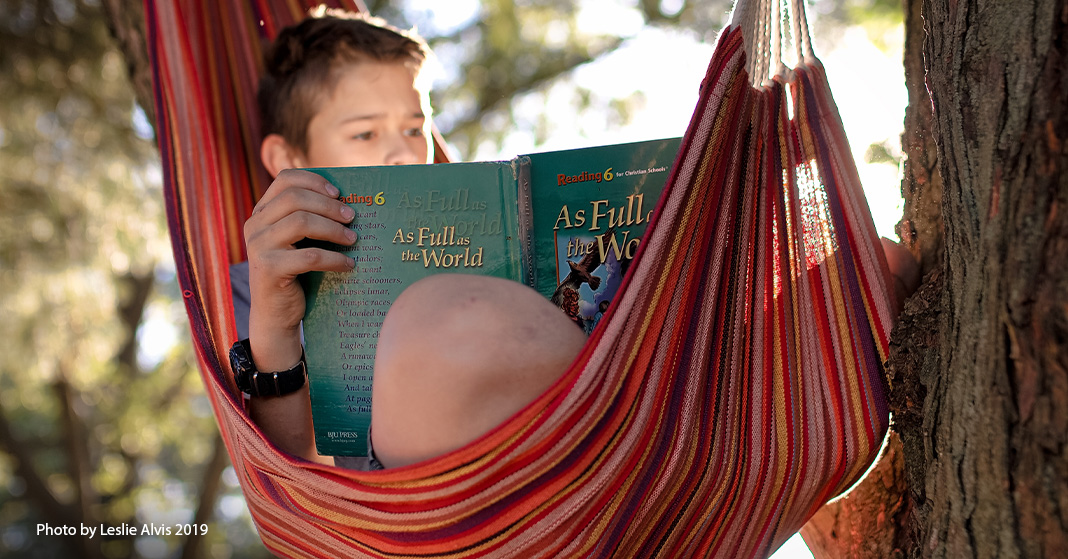
My best friend has always insisted that she is not creative. It’s true that she doesn’t gravitate toward crafty projects. But scrapbooking and making art are not the only ways to be creative. Creative thinking is being able to use what you already know to solve a problem you’ve never seen before. And my friend does that all the time as a doctor in the emergency room. Medical doctors need a strong knowledge base. But they also have to be able to connect that knowledge to the patient sitting in front of them.
Is creative thinking an innate skill, or can you teach it to your children? God, the most creative thinker, made us in His image. Therefore, we all have the potential to think creatively. You can help your children learn to connect prior knowledge to new problems. Here are some ways to instill creative thinking.
Add variety to the learning environment.
You have probably designated a place in your home for learning. The benefit to learning and testing in the same place is that it aids memory and recall. However, varying the environment strengthens the ability to apply knowledge in a new context. Homeschooling allows more opportunity for changing the learning environment than traditional classrooms can. Using a variety of teaching methods also promotes creative thinking. Use analogies in your teaching to connect new concepts back to what your kids already know. The variety of environments and methods promotes a variety of mental connections.
Ask open-ended questions.
Before teaching new content, ask questions like, “Since you know seven times five, how would you solve seven times six? What would you try first?” Notice the hint about what prior knowledge will be helpful to apply. The hint gives your children confidence, when faced with a new question. Asking what they would try first, implies that they may need more than one try to solve the problem. Even outside of school, you can entertain open-ended questions that begin with “What if.” Ask your children to think about what they would do in different scenarios, realistic or imaginary. What if we are on a field trip and you can’t find me? What if you could have any superpower you wanted? Let them imagine scenarios they have not encountered by thinking creatively.
Have them explain in their own words.
Ask your children to describe what they have learned recently to Grandma. You can also ask them to teach a younger sibling what they have learned. They will have to know it well enough to use their own words and make it simple. Even an above average student will benefit from study groups. Explaining content to others helps move that knowledge from short-term to long-term memory. The better they remember information, the more likely they will be able to connect that knowledge to new areas.
Encourage collaboration.
Your children may be able to collaborate on some problems at home. If not, be sure to include interactions with other children in your schedule. Giving kids projects to work on together can increase their confidence when they don’t have all the answers. Connecting with people who think differently broadens the scope of their thinking. Working in groups gives kids confidence to think creatively on their own. At the park recently, I saw a group of Boy Scouts tying knots together. The next time one of them needs a knot, what will he do? He will remember that collaboration and connect the dots from what he learned then to the new problem he faces.
Practice.
After teaching in a way that promotes creative thinking, be sure to practice. Thinking creatively is not limited to science and math. Any subject will do. Like any skill, getting better at creative thinking comes with more practice. Inevitably, your children will be unsuccessful. They may not be able to connect to prior knowledge at first. Some kids will be frustrated when solutions are not easy to find. The word “yet” is valuable. When your child says, “My idea isn’t working,” you can add, “yet.” When she says, “I can’t do this,” again you add, “yet.” Talk to your children about times when you had to try again and again. Remind them that a solution that doesn’t work is useful. You know what won’t work, and now you can try other possibilities. Thomas Edison is credited with saying, “I have not failed. I’ve just found 10,000 ways that won’t work.” Kids and adults can learn to think creatively with intent and practice. If you’re hoping to teach your children to think creatively, what would you try first?
• • • • •
Valerie is a wife and a mother to a very busy toddler. In her free time she enjoys reading all kinds of books. She earned a B.S. in Biology from Bob Jones University, minoring in Mathematics, and a Ph.D. in Molecular Genetics from Ohio State University. Valerie has 15 years of experience working in research laboratories and has coauthored 8 original research articles. She has also taught several classes and laboratories at the high school and college levels. She currently works as a Data Analyst and a freelance writer.
Leave a Reply